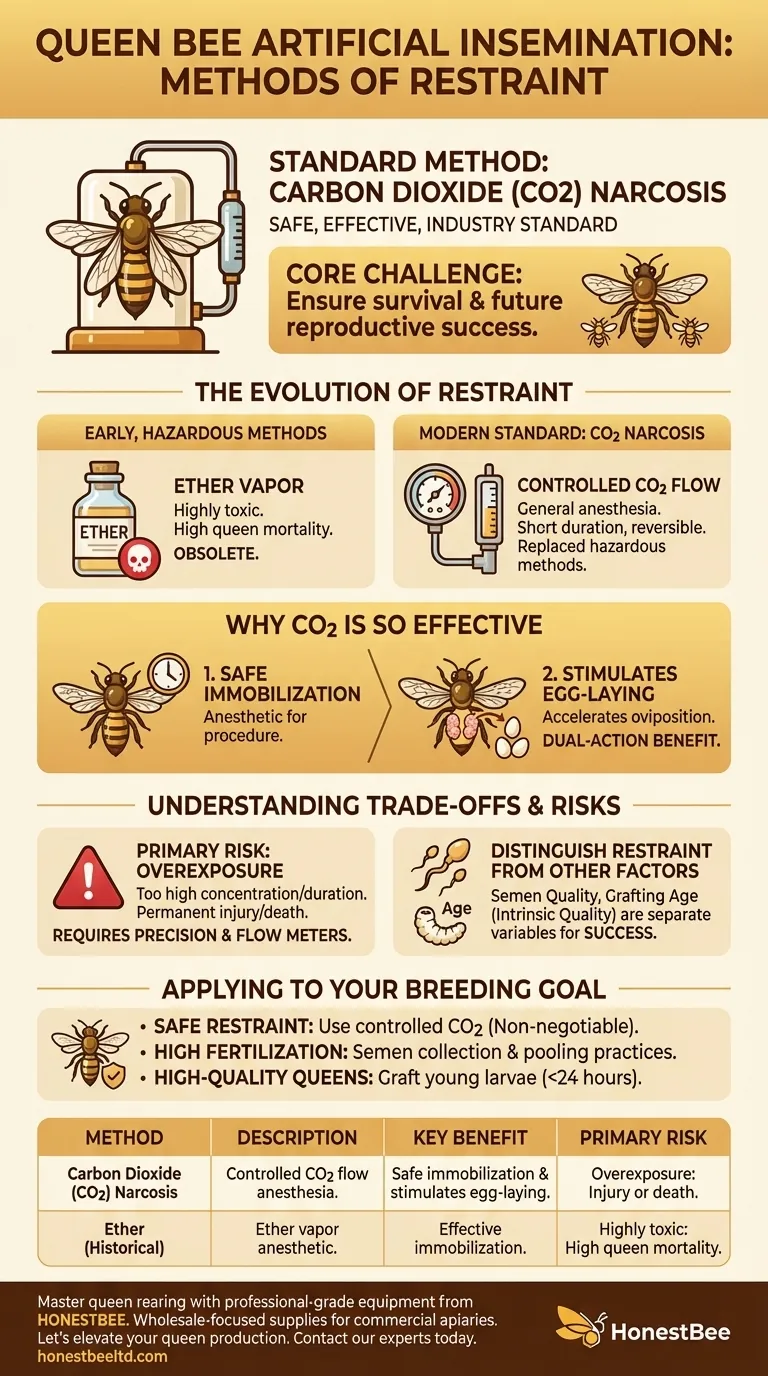The standard method for restraining queen bees during artificial insemination is carbon dioxide (CO2) narcosis. This technique serves as a safe and effective anesthetic, immobilizing the queen for the delicate procedure. It replaced earlier, more hazardous methods like using ether, which often resulted in high queen mortality.
The core challenge in artificial insemination is not just restraining the queen, but doing so in a way that ensures her survival and future reproductive success. CO2 narcosis has become the industry standard because it effectively immobilizes the queen while also stimulating the onset of egg-laying.

The Evolution of Queen Restraint
The methods for handling queens during insemination have evolved significantly. Early techniques were often crude and dangerous, but the development of controlled anesthesia revolutionized the process and made large-scale queen breeding possible.
Early, Hazardous Methods
Initial attempts at queen insemination involved anesthetics like ether. While effective at immobilization, ether proved to be highly toxic to honey bees, leading to unacceptable rates of queen loss.
The Modern Standard: Carbon Dioxide (CO2) Narcosis
CO2 narcosis is a form of general anesthesia that renders the queen unconscious and immobile for a short period. A controlled flow of pure CO2 is administered to the queen, who is secured in the insemination apparatus.
The process is reversible, and queens typically recover quickly with no lasting harm when the procedure is performed correctly.
Why CO2 is So Effective
Beyond simple restraint, CO2 has a secondary benefit that makes it uniquely suited for this task. Exposing a virgin queen to carbon dioxide stimulates her ovaries and accelerates the commencement of oviposition (egg-laying).
This dual-action effect makes CO2 an invaluable tool, serving as both an anesthetic for the procedure and a physiological trigger for the queen's reproductive functions.
Understanding the Trade-offs and Risks
While CO2 narcosis is the standard, its application requires precision and care. The success of the overall breeding program also depends on factors that occur long before the insemination itself.
The Danger of Overexposure
The primary risk associated with CO2 is overdose. Exposing a queen to too high a concentration or for too long a duration can cause permanent injury or death. Technicians must use specialized equipment with flow meters to ensure a precise, controlled dose.
Distinguishing Restraint from Other Factors
It is critical to separate the method of restraint from other variables that determine success. Factors like the quality and handling of drone semen are vital for fertilization but are distinct from the insemination procedure itself.
Similarly, the intrinsic quality of the queen, determined by factors like the larval age at grafting, has a profound impact on her reproductive capacity. A well-restrained queen is useless if she was not well-bred from the start.
Applying This to Your Breeding Goal
Successfully producing artificially inseminated queens requires a holistic approach where proper restraint is one critical step in a larger process.
- If your primary focus is safe and effective restraint: Using controlled CO2 narcosis is the non-negotiable industry standard for both queen safety and procedural stability.
- If your primary focus is achieving high fertilization rates: Your protocol must include best practices for semen collection and handling, such as pooling from multiple drones to ensure genetic diversity and viability.
- If your primary focus is producing high-quality queens: The process must begin with grafting very young larvae (under 24 hours old) to maximize the queen's future reproductive potential.
Mastering these controlled techniques in unison is the key to any successful and repeatable queen breeding program.
Summary Table:
| Method | Description | Key Benefit | Primary Risk |
|---|---|---|---|
| Carbon Dioxide (CO2) Narcosis | Administering a controlled flow of CO2 to anesthetize the queen. | Safe immobilization & stimulates egg-laying. | Overexposure can cause injury or death. |
| Ether (Historical) | Using ether vapor as an anesthetic. | Effective immobilization. | Highly toxic; causes high queen mortality. |
Master the art of queen rearing with professional-grade equipment from HONESTBEE.
Successful artificial insemination requires precision, from safe queen restraint with CO2 to proper semen handling. HONESTBEE supplies commercial apiaries and beekeeping equipment distributors with the reliable, wholesale-focused supplies needed for every step of a successful breeding program.
Let's elevate your queen production. Contact our experts today to discuss your specific equipment needs.
Visual Guide

Related Products
- No Grafting Queen Rearing Kit: System for Royal Jelly Production and Queen Rearing
- Plastic Chinese Queen Grafting Tool for Bee Queen Rearing
- Black 2 Pack Beekeeper Queen Grafting Tool for Bee Queen Larva Transferring Needle
- HONESTBEE Advanced Ergonomic Stainless Steel Hive Tool for Beekeeping
- Professional Dual-End Stainless Steel Hive Tool for Beekeeping
People Also Ask
- What steps should be taken if a queen is lost? Save Your Queenless Hive Now
- What are the signs that indicate a colony needs requeening? Protect Your Hive's Health and Productivity
- What is the timeline for queen breeding? A 28-Day Guide from Egg to Laying Queen
- What is requeening, and why is it performed? Take Control of Your Hive's Health and Productivity
- What are the developmental periods for different bee castes? Master the 16, 21, and 24-Day Timelines for Hive Success



















